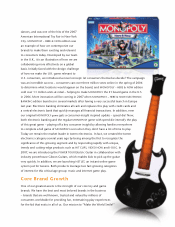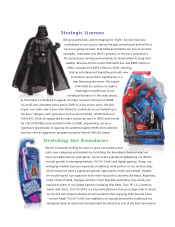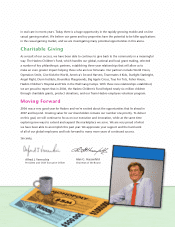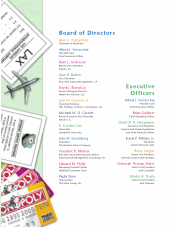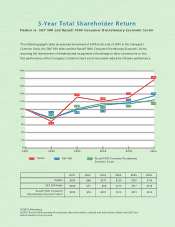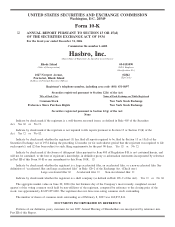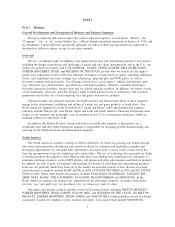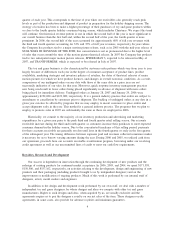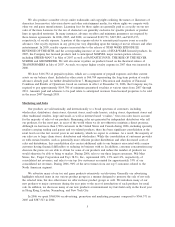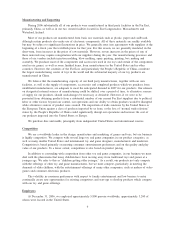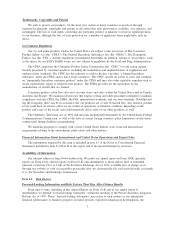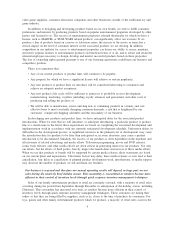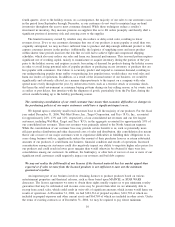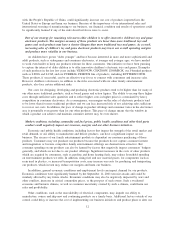Hasbro 2006 Annual Report Download - page 15
Download and view the complete annual report
Please find page 15 of the 2006 Hasbro annual report below. You can navigate through the pages in the report by either clicking on the pages listed below, or by using the keyword search tool below to find specific information within the annual report.
quarter of each year. This corresponds to the time of year when our receivables also generally reach peak
levels as part of the production and shipment of product in preparation for the holiday shipping season. The
strategy of retailers has been to make a higher percentage of their purchases of toy and game products within
or close to the fourth quarter holiday consumer buying season, which includes Christmas. We expect this trend
will continue. Our historical revenue pattern is one in which the second half of the year is more significant to
our overall business than the first half and, within the second half of the year, the fourth quarter is more
prominent. In 2006, the second half of the year accounted for approximately 68% of full year revenues with
the third and fourth quarters accounting for 33% and 35% of full year revenues, respectively. In years where
the Company has products tied to a major motion picture release, such as in 2005 with the mid-year release of
STAR WARS III: REVENGE OF THE SITH, this concentration is not as pronounced due to the higher level
of sales that occur around the time of the motion picture theatrical release. In 2007 the Company has products
tied to two anticipated major motion picture releases, SPIDER-MAN 3, expected to be released in May of
2007, and TRANSFORMERS, which is expected to be released in July of 2007.
The toy and game business is also characterized by customer order patterns which vary from year to year
largely because of differences each year in the degree of consumer acceptance of product lines, product
availability, marketing strategies and inventory policies of retailers, the dates of theatrical releases of major
motion pictures for which we have product licenses, and changes in overall economic conditions. As a result,
comparisons of our unshipped orders on any date with those at the same date in a prior year are not
necessarily indicative of our sales for that year. Moreover, quick response inventory management practices
now being used result in fewer orders being placed significantly in advance of shipment with more orders
being placed for immediate delivery. Unshipped orders at January 28, 2007 and January 29, 2006 were
approximately $192,000 and $123,000, respectively. It is a general industry practice that orders are subject to
amendment or cancellation by customers prior to shipment. The backlog of unshipped orders at any date in a
given year can also be affected by programs that we may employ to incent customers to place orders and
accept shipments early in the year. This method is a general industry practice. The programs that we plan to
employ to promote sales in 2007 are substantially the same as those we employed in 2006.
Historically, we commit to the majority of our inventory production and advertising and marketing
expenditures for a given year prior to the peak third and fourth quarter retail selling season. Our accounts
receivable increase during the third and fourth quarter as customers increase their purchases to meet expected
consumer demand in the holiday season. Due to the concentrated timeframe of this selling period, payments
for these accounts receivable are generally not due until later in the fourth quarter or early in the first quarter
of the subsequent year. The timing difference between expenses paid and revenues collected sometimes makes
it necessary for us to borrow varying amounts during the year. During 2006 and 2005, we utilized cash from
our operations, proceeds from our accounts receivable securitization program, borrowing under our revolving
credit agreement as well as our uncommitted lines of credit to meet our cash flow requirements.
Royalties, Research and Development
Our success is dependent on innovation through the continuing development of new products and the
redesign of existing products for continued market acceptance. In 2006, 2005, and 2004, we spent $171,358,
$150,586, and $157,162, respectively, on activities relating to the development, design and engineering of new
products and their packaging (including products brought to us by independent designers) and on the
improvement or modification of ongoing products. Much of this work is performed by our internal staff of
designers, artists, model makers and engineers.
In addition to the design and development work performed by our own staff, we deal with a number of
independent toy and game designers for whose designs and ideas we compete with other toy and game
manufacturers. Rights to such designs and ideas, when acquired by us, are usually exclusive and the
agreements require us to pay the designer a royalty on our net sales of the item. These designer royalty
agreements, in some cases, also provide for advance royalties and minimum guarantees.
4


